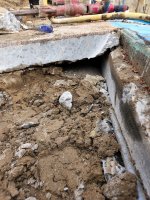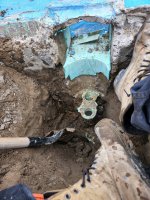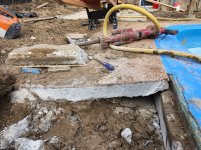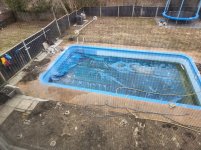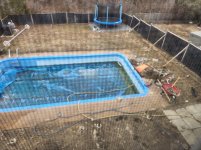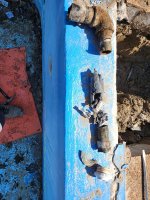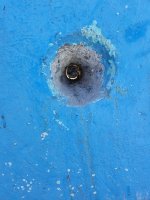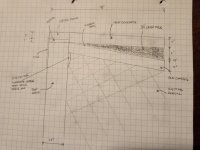First off, great site and such a wealth of knowledge! I have learned quite a bit just lurking around for the past year.
Hoping to get some advice from this thread and maybe it might help someone else along their journey.
A little back story on how I got to where I am now with my pool. This is going to be a long one.
I bought a house last year with a concrete pool that was in bad shape. Its a 16x32 (approx. 19,000 gallons) salt free chlorine pool.
We bought the house during the winter months when everything was covered in snow but was told that the pool worked fine and all the equipment was in working order. From what we could see, the equipment looked old, and the concrete deck was sloping with a rubber deck coating on it. We figured we could open the pool and use it for the season and come the following year, get the deck torn out and a new pattern concrete deck installed.
Come springtime, I peeled back the cover and it was a mess. First thing I noticed was the pool was painted, but the paint was all chipped off and floating in the water. There was also no coping stone or any coping for that matter. The walls were painted blue and right up and cover to the top of the on beam. The skimmer was cracked and heled together with JB weld or something. For the equipment, it was only a sand filter and pump, but the sand filter was cracked and held together with the same thing the skimmer was and the pump was burnt out. Moreover, I found a hole in one of the basement windows where they strung an extension cord out to hook the pump up. Unbelievable!
Right off the hop, pool needed to be opened for the season as per the boss' instructions. Kids are home all summer due to Covid.
Before we moved in, we talked about getting a heater and that was still a priority. So, on top of buying a new Hayward Pump and Jandy sand filter, we also purchased a 266 BTU gas heater.
Due to building code requirements, we were unable to put the heater to where the old equipment was so, I had move everything to the to the other side of the yard. which is about 100 ft from where the old equipment was and about 130 ft away from my gas meter. I poured a concrete pad ran the electrical and had the gas ran to the pad. I didn't want to break up the deck this year, so I left the plumbing as it was and just tapped into where the old equipment was and ran new plumbing from where the old equipment was to the new equipment and back. Then pressure tested the lines and back filled the trench.
With that out of the way, I needed to drain the pool to repaint it with the same acrylic pain that was originally used. Chipped off all the lose paint and sanded/scuffed the walls and floors. Repainted and filled the pool.
Yay! pool was ready for summer.
Some issues I noticed over the summer while using the pool.
New paint kept bubbling in spots almost right away, not a big deal though.
Losing about an inch of water a day. Thought it was evaporation but turns out its a leak. I figured it was leaking from the skimmer and would just keep toping off and address the issue next year when digging up to replace the skimmer.
Hoping to get some advice from this thread and maybe it might help someone else along their journey.
A little back story on how I got to where I am now with my pool. This is going to be a long one.
I bought a house last year with a concrete pool that was in bad shape. Its a 16x32 (approx. 19,000 gallons) salt free chlorine pool.
We bought the house during the winter months when everything was covered in snow but was told that the pool worked fine and all the equipment was in working order. From what we could see, the equipment looked old, and the concrete deck was sloping with a rubber deck coating on it. We figured we could open the pool and use it for the season and come the following year, get the deck torn out and a new pattern concrete deck installed.
Come springtime, I peeled back the cover and it was a mess. First thing I noticed was the pool was painted, but the paint was all chipped off and floating in the water. There was also no coping stone or any coping for that matter. The walls were painted blue and right up and cover to the top of the on beam. The skimmer was cracked and heled together with JB weld or something. For the equipment, it was only a sand filter and pump, but the sand filter was cracked and held together with the same thing the skimmer was and the pump was burnt out. Moreover, I found a hole in one of the basement windows where they strung an extension cord out to hook the pump up. Unbelievable!
Right off the hop, pool needed to be opened for the season as per the boss' instructions. Kids are home all summer due to Covid.
Before we moved in, we talked about getting a heater and that was still a priority. So, on top of buying a new Hayward Pump and Jandy sand filter, we also purchased a 266 BTU gas heater.
Due to building code requirements, we were unable to put the heater to where the old equipment was so, I had move everything to the to the other side of the yard. which is about 100 ft from where the old equipment was and about 130 ft away from my gas meter. I poured a concrete pad ran the electrical and had the gas ran to the pad. I didn't want to break up the deck this year, so I left the plumbing as it was and just tapped into where the old equipment was and ran new plumbing from where the old equipment was to the new equipment and back. Then pressure tested the lines and back filled the trench.
With that out of the way, I needed to drain the pool to repaint it with the same acrylic pain that was originally used. Chipped off all the lose paint and sanded/scuffed the walls and floors. Repainted and filled the pool.
Yay! pool was ready for summer.
Some issues I noticed over the summer while using the pool.
New paint kept bubbling in spots almost right away, not a big deal though.
Losing about an inch of water a day. Thought it was evaporation but turns out its a leak. I figured it was leaking from the skimmer and would just keep toping off and address the issue next year when digging up to replace the skimmer.
Attachments
-
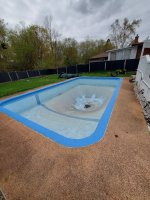 20210505_155005.jpg207.2 KB · Views: 243
20210505_155005.jpg207.2 KB · Views: 243 -
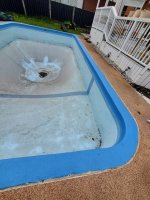 20210505_155010.jpg179.3 KB · Views: 229
20210505_155010.jpg179.3 KB · Views: 229 -
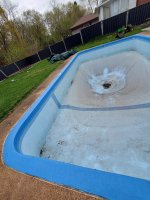 20210505_155014.jpg171.4 KB · Views: 215
20210505_155014.jpg171.4 KB · Views: 215 -
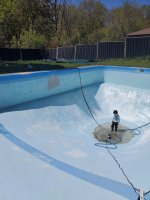 20210512_140422.jpg147.6 KB · Views: 218
20210512_140422.jpg147.6 KB · Views: 218 -
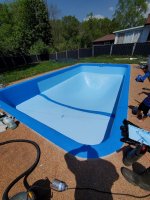 20210518_121107.jpg191.6 KB · Views: 228
20210518_121107.jpg191.6 KB · Views: 228 -
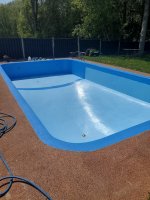 20210518_121427.jpg187.1 KB · Views: 229
20210518_121427.jpg187.1 KB · Views: 229 -
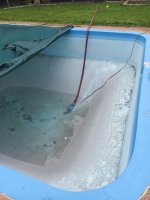 cover off.jpg130.7 KB · Views: 238
cover off.jpg130.7 KB · Views: 238 -
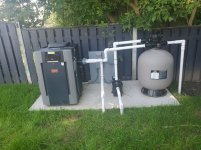 equipment.jpg323.7 KB · Views: 240
equipment.jpg323.7 KB · Views: 240


